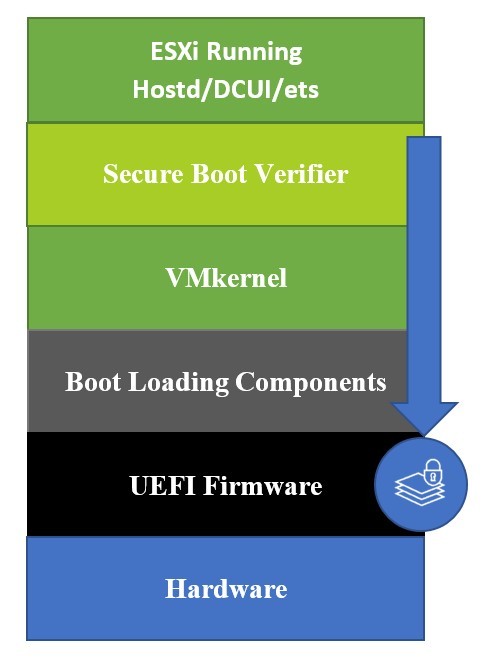VMware Introduces HTML5 Client vSphere Client Fling v3.0
In October 2016, VMworld Europe 2016 was held in Barcelona, during which VMware announced a new version of the VMware vSphere 6.5 server platform .
 / photo David Precious CC
/ photo David Precious CC
This release was accompanied by the introduction of new features designed to improve performance in the digital environment. For example, VMware has finally introduced the ability to encrypt data at the VMDK virtual disk level, which operates independently of the VM's guest operating system. The functionality is organized on the basis of the AES-NI algorithm (key management is implemented using the KMIP 1.1 standard), and I / O operations are encrypted in real time on the fly.
')
Also, the ability to encrypt VM hot migration traffic (vMotion Encryption) - encryption is performed at the level of an individual VM using 256-bit keys. Additionally, we note the appearance of the Secure Boot functionality, or secure boot. Now the UEFI firmware performs a digital signature verification of the VMkernel core to prevent third-party software from modifying the hypervisor core.

The company also talked about the emergence of the function Proactive HA - the mechanism of active detection of host failures. At the moment the hardware sensor triggers, the faulty host is placed in “quarantine” - while it stops participating in the migration of new machines, and the working machines are removed from it by the DRS mechanism. Also, VMware HA allows you to take into account the relationship of services in the VM - recovery after a failure will be performed according to the specified priority and dependency rules.
At that conference, VMware presented many more features and solutions (the full set of which you can find at the link ), but what the company did not do - it did not announce a new vSphere Client. But the company promised to present the product in the near future. And here, on January 10, 2017, the HTML5 client vSphere Client Fling v3.0 saw the light.
The new client fully supports the functionality of vSphere 6.5 and has several innovations. The first of these is the virtual machine deployment feature from the OVF template that users have been asking for a very long time.
The feature only works with vSphere 6.5 due to compatibility issues. The vSphere Client was created to avoid dependency on Flash and CPI (Client Integration Plugin), in addition, new APIs are only available in the latest version. You can find more information about the consequences of rejecting CIP in this video:
The second new feature in Fling is the ability to deploy a virtual machine from a template in the Content Library. To do this, the UX was also changed - now you don’t need to go through the tabs “New VM → New VM from Library”, and the function is available directly in the customizer when creating a new virtual machine on the first page. According to the company, in the future, the same window will give users the opportunity to choose templates stored outside the Content Library.
As for the third added function, this is the ability to move a virtual machine using Drag and Drop in the “VMs and Templates” view. While this feature is at the testing stage, and at the moment some features are not available. The company assures that it will expand the functionality in the near future.
Download the client and follow the latest changes here on this link .
PS And here are some more materials on the topic from our blog:
 / photo David Precious CC
/ photo David Precious CCThis release was accompanied by the introduction of new features designed to improve performance in the digital environment. For example, VMware has finally introduced the ability to encrypt data at the VMDK virtual disk level, which operates independently of the VM's guest operating system. The functionality is organized on the basis of the AES-NI algorithm (key management is implemented using the KMIP 1.1 standard), and I / O operations are encrypted in real time on the fly.
')
Also, the ability to encrypt VM hot migration traffic (vMotion Encryption) - encryption is performed at the level of an individual VM using 256-bit keys. Additionally, we note the appearance of the Secure Boot functionality, or secure boot. Now the UEFI firmware performs a digital signature verification of the VMkernel core to prevent third-party software from modifying the hypervisor core.

The company also talked about the emergence of the function Proactive HA - the mechanism of active detection of host failures. At the moment the hardware sensor triggers, the faulty host is placed in “quarantine” - while it stops participating in the migration of new machines, and the working machines are removed from it by the DRS mechanism. Also, VMware HA allows you to take into account the relationship of services in the VM - recovery after a failure will be performed according to the specified priority and dependency rules.
At that conference, VMware presented many more features and solutions (the full set of which you can find at the link ), but what the company did not do - it did not announce a new vSphere Client. But the company promised to present the product in the near future. And here, on January 10, 2017, the HTML5 client vSphere Client Fling v3.0 saw the light.
The new client fully supports the functionality of vSphere 6.5 and has several innovations. The first of these is the virtual machine deployment feature from the OVF template that users have been asking for a very long time.
The feature only works with vSphere 6.5 due to compatibility issues. The vSphere Client was created to avoid dependency on Flash and CPI (Client Integration Plugin), in addition, new APIs are only available in the latest version. You can find more information about the consequences of rejecting CIP in this video:
The second new feature in Fling is the ability to deploy a virtual machine from a template in the Content Library. To do this, the UX was also changed - now you don’t need to go through the tabs “New VM → New VM from Library”, and the function is available directly in the customizer when creating a new virtual machine on the first page. According to the company, in the future, the same window will give users the opportunity to choose templates stored outside the Content Library.
As for the third added function, this is the ability to move a virtual machine using Drag and Drop in the “VMs and Templates” view. While this feature is at the testing stage, and at the moment some features are not available. The company assures that it will expand the functionality in the near future.
Download the client and follow the latest changes here on this link .
PS And here are some more materials on the topic from our blog:
- VMware NSX: A New Approach to Health Security
- VMware Cloud Foundation: Simplified Software Data Center and Hybrid Cloud Deployment
- VMware Virtual SAN (vSAN) Solution Features
- VMware Tools VMware Review: Understanding the Features
- Virtual and Cloud Infrastructure Management - VMware vSphere PowerCLI. Part 1
- Virtual and Cloud Infrastructure Management - VMware vSphere PowerCLI. Part 2
- What are vSphere embedded containers and why are VCHs created?
- Introduce a private cloud in a network of educational institutions based on NetApp and VMware
- Log Insight: Continuing Acquaintance with VMware Cloud Logging Solution
- Solving the problem of network connection loss in VMware virtual machines in the IaaS cloud
Source: https://habr.com/ru/post/319612/
All Articles